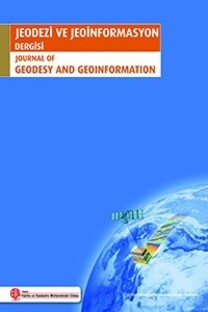Tekrarlı yaya yürüyüşü ve kısa süreli kinematik GPS+GLONASS gözlemleriyle PPP yönteminin performans analizi
Küresel Konum Belirleme ve Uydu Sistemleri (Global Navigation Satellite Systems, GNSS) tabanlı konum belirleme uygulamalarında Hassas Nokta Konum Belirleme (Precise Point Positioning-PPP) yönteminin etkinliği ve kullanımı bağıl konum belirlemeye göre giderek artmaktadır. Buna karşın farklı platformlarda gerçekleştirilen statik ve kinematik moddaki birçok çalışmada geleneksel standart PPP yöntemi için en büyük dezavantaj taşıyıcı faz gözlemleri için yakınsama süresinin uzun olmasıdır. Bu nedenle PPP’ye dayalı statik ve kinematik moddaki çalışmalarda gözlem süresi sıklıkla uzun tutulmaktadır. Gerçekleştirilen bu çalışmada PPP’de gözlem süresine ve dolayısıyla tamsayı belirsizliği çözümüne bağlı olarak elde edilen konum doğruluğu dikkate alınarak, tekrarlı ve kısa süreli yaya yürüyüşleriyle elde edilen kinematik GPS+GLONASS gözlemlerinin PPP konum belirleme performansı kısa, orta ve uzun bazlar için bağıl konum belirleme çözümleriyle karşılaştırılmıştır. Karşılaştırma için dünya genelinde yaygın olarak kullanılan ve taşıyıcı faz gözlemleri için yakınsama süresinin kısaltılması için yeni algoritmik yaklaşımlar kullanan internet tabanlı GNSS veri değerlendirme servisi CSRS-PPP tercih edilmiştir. Sonuçlar PPP yönteminin kısa süreli kinematik gözlemler için de bağıl çözümlere eşdeğer sayılacak yüksek doğrulukta konum bilgisinin elde edilmesinde etkin olarak kullanılabileceğini açıkça ortaya koymaktadır.
Anahtar Kelimeler:
Hassas nokta konum belirleme, Kinematik konum belirleme, GPS+GLONASS, Kısa gözlem süresi
Performance analysis of PPP method with repeatedly pedestrian walk and short-time kinematic GPS+GLONASS observations
In Global Navigation Satellite Systems (GNSS)- based positioning applications, the efficiency and use of Precise Point Positioning (PPP) technique have gradually increased compared to the relative positioning technique. However, in many studies performed on different platforms in static and kinematic modes, the largest disadvantage for the traditional standard PPP method is the long convergence time for carrier phase observations. Therefore, observation duration in studies that are based on the PPP method in static and kinematic modes is often kept long. In this study, considering the positioning accuracy obtained depending on observation duration and ambiguity resolution in PPP, the performance of kinematic GPS+GLONASS observations obtained by repeated and short pedestrian walks were compared with relative positioning solutions for short, medium and long bases. For comparison, the internet-based GNSS data processing service namely CSRS-PPP, which is widely used worldwide and uses new algorithmic approaches to shorten the convergence time for carrier-phase observations, was preferred. The results clearly demonstrate that the PPP method for short-term kinematic observations can be used effectively for obtaining high-accurate positioning information, which is also equivalent to relative solutions.
Keywords:
Precise point positioning, Kinematic positioning, GPS+GLONASS, Short observation duration,
___
- Alkan, R. M., & Öcalan, T. (2013). Usability of the GPS precise point positioning technique in marine applications. The Journal of Navigation, 66(4), 579-588.
- Alkan, R. M., Saka, M. H., Ozulu, İ. M., & İlçi, V. (2017). Kinematic precise point positioning using GPS and GLONASS measurements in marine environments. Measurement, 109, 36-43.
- Bezcioğlu, M., Yiğit, C. Ö., & Bodur, M. N. (2019). Kinematik PPP-AR ve Geleneksel PPP Yöntemlerin Performanslarının Değerlendirilmesi: Antarktika Yarımadası Örneği. Afyon Kocatepe Üniversitesi Fen Ve Mühendislik Bilimleri Dergisi, 19(1), 162-169.
- Bisnath, S., & Gao, Y. (2008). Current state of precise point positioning and future prospects and limitations. Observing our changing earth, 615-623. Springer, Berlin.
- Chen, K., & Gao, Y. (2005). Real-time precise point positioning using single frequency data. Proceedings of ION GNSS, 1514–1523.
- Choy, S., & Harima, K. (2019). Satellite delivery of high-accuracy GNSS precise point positioning service: an overview for Australia. Journal of Spatial Science, 64(2), 197-208.
- El-Mowafy, A. (2011). Analysis of web-based GNSS post-processing services for static and kinematic positioning using short data spans. Survey review, 43(323), 535-549.
- Erdoğan, B., Karlıtepe, F., Öcalan, T., & Tunalıoğlu, N. (2018). Performance analysis of Real Time PPP for transit of Mercury. Measurement, 129, 358-367.
- Geng, J., Teferle, F. N., Meng, X., & Dodson, A. H. (2010). Kinematic precise point positioning at remote marine platforms. GPS solutions, 14(4), 343-350.
- Grayson, B., Penna, N. T., Mills, J. P., & Grant, D. S. (2018). GPS precise point positioning for UAV photogrammetry. The Photogrammetric Record, 33(164), 427-447.
- Gross, J. N., Watson, R. M., D’Urso, S., & Gu, Y. (2016). Flight-test evaluation of kinematic precise point positioning of small UAVs. International Journal of Aerospace Engineering, 2016 id 1259893.
- Héroux, P., Gao, Y., Kouba, J., Lahaye, F., Mireault, Y., Collins, P., Tètreault, P., & Chen, K. (2004). Products and applications for Precise Point Positioning-Moving towards real-time. Proceedings of ION GNSS, 1832-1843.
- Li, X., Ge, M., Zhang, H., & Wickert, J. (2013). A method for improving uncalibrated phase delay estimation and ambiguity-fixing in real-time precise point positioning. Journal of Geodesy, 87(5), 405-416.
- Lipatnikov, L.A., & Shevchuk, S.O. (2019), Cost Effective Precise Positioning with GNSS, The International Federation of Surveyors (FIG), No: 74.
- Öcalan, T., Erdoğan, B., Tunalıoğlu, N., & Durdağ, U.M. (2016). Accuracy Investigation of PPP Method Versus Relative Positioning Using Different Satellite Ephemerides Products Near/Under Forest Environment. Earth Sciences Research Journal, 20(4), D1-D9.
- Robustelli, U., Baiocchi, V., & Pugliano, G. (2019). Assessment of dual frequency GNSS observations from a Xiaomi Mi 8 Android smartphone and positioning performance analysis. Electronics, 8(1), 91.
- Wübbena, G., Schmitz, M., & Bagge, A. (2005). PPP-RTK: precise point positioning using state-space representation in RTK networks. Proceedings of ION GNSS ,5 13-16.
- Xu, P., Shi, C., Fang, R., Liu, J., Niu, X., Zhang, Q., & Yanagidani, T. (2013). High-rate precise point positioning (PPP) to measure seismic wave motions: an experimental comparison of GPS PPP with inertial measurement units. Journal of Geodesy, 87(4), 361-372.
- Yiğit, C. Ö. (2016). Experimental assessment of post-processed kinematic Precise Point Positioning method for structural health monitoring. Geomatics, natural hazards and risk, 7(1), 360-383.
- Zumberge, J. F., Heflin, M. B., Jefferson, D. C., Watkins, M. M., & Webb, F. H. (1997). Precise point positioning for the efficient and robust analysis of GPS data from large networks. Journal of geophysical research: solid earth, 102(B3), 5005-5017.
- URL-1: https://webapp.geod.nrcan.gc.ca/geod/tools-outils/documentation.php, (Erişim Tarihi: 2 Mayıs 2020).
- ISSN: 2147-1339
- Yayın Aralığı: Yılda 2 Sayı
- Başlangıç: 2012
- Yayıncı: TMMOB Harita ve Kadastro Mühendisleri Odası
